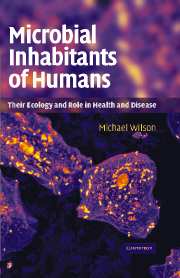Book contents
- Frontmatter
- Contents
- Preface
- Abbreviations used for microbial genera
- 1 An introduction to the human–microbe symbiosis
- 2 The skin and its indigenous microbiota
- 3 The eye and its indigenous microbiota
- 4 The respiratory system and its indigenous microbiota
- 5 The urinary system and its indigenous microbiota
- 6 The reproductive system and its indigenous microbiota
- 7 The gastrointestinal tract and its indigenous microbiota
- 8 The oral cavity and its indigenous microbiota
- 9 Role of the indigenous microbiota in maintaining human health
- 10 Manipulation of the indigenous microbiota
- Index
10 - Manipulation of the indigenous microbiota
Published online by Cambridge University Press: 06 July 2010
- Frontmatter
- Contents
- Preface
- Abbreviations used for microbial genera
- 1 An introduction to the human–microbe symbiosis
- 2 The skin and its indigenous microbiota
- 3 The eye and its indigenous microbiota
- 4 The respiratory system and its indigenous microbiota
- 5 The urinary system and its indigenous microbiota
- 6 The reproductive system and its indigenous microbiota
- 7 The gastrointestinal tract and its indigenous microbiota
- 8 The oral cavity and its indigenous microbiota
- 9 Role of the indigenous microbiota in maintaining human health
- 10 Manipulation of the indigenous microbiota
- Index
Summary
Although the previous chapter has emphasised the benefits which we derive from the presence of our indigenous microbiota, it must be remembered that the microbiota of each body site also contains organisms that are able to cause disease. Methods of altering the microbiota of a site to increase the benefits it confers or to decrease its ability to cause disease are, therefore, of great interest and practical importance. An obvious way of altering the microbiota of a body site is to use antibiotics, and these chemotherapeutic agents have been used widely to prevent and treat infections due to indigenous microbes. The availability of effective and cheap antibiotics in the latter half of the twentieth century revolutionised the treatment of infectious diseases and, for developed countries at least, reduced their impact as major causes of death and disability. Indeed, the Nobel laureate immunologist, Macfarlane Burnett, stated in 1962 that “by the late twentieth century we can anticipate the virtual elimination of infectious disease as a significant factor in social life”. However, the development of resistance to a range of antibiotics by some important pathogens, including many indigenous organisms (e.g., Staph. aureus, Strep. pneumoniae, N. meningitidis, H. influenzae, E. coli), has raised the possibility of a return to the pre–antibiotic “dark ages”. Other adverse effects of antibiotic administration on the indigenous microbiota were also described in Chapters 2–9. There is, therefore, great interest in the development of other approaches to manipulating the indigenous microbiota that do not result in such side effects.
- Type
- Chapter
- Information
- Microbial Inhabitants of HumansTheir Ecology and Role in Health and Disease, pp. 395 - 420Publisher: Cambridge University PressPrint publication year: 2004
- 1
- Cited by



